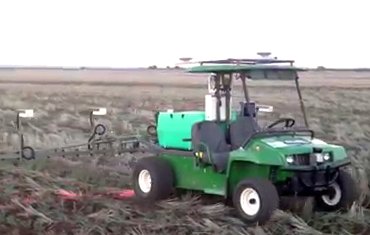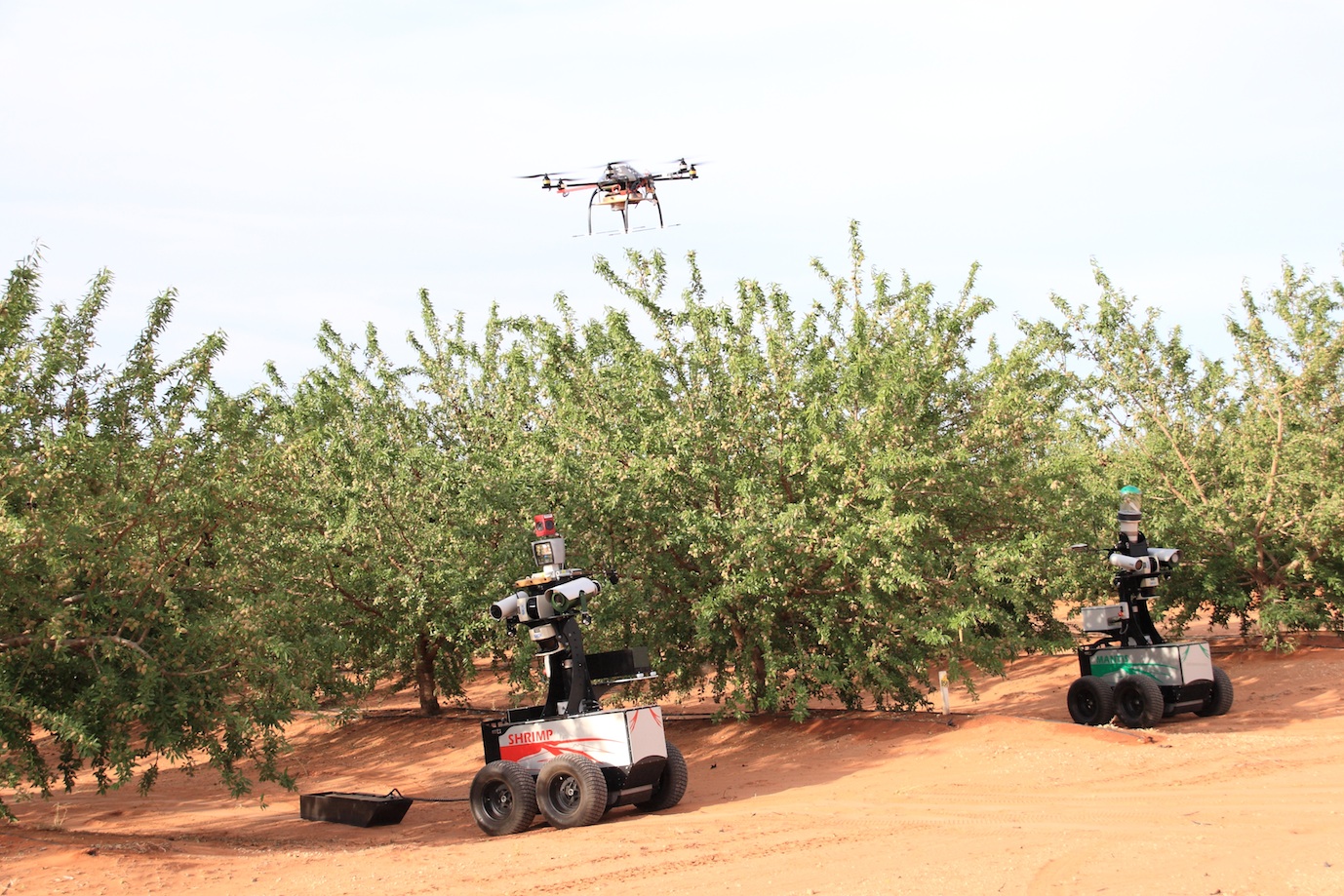Robotics and intelligent systems for large scale agriculture
Author: Robert Fitch and Salah Sukkarieh, Australian Centre for Field Robotics, School of Aerospace, Mechanical and Mechatronic Engineering, University of Sydney, NSW | Date: 19 Mar 2014
Robert Fitch and Salah Sukkarieh
(Australian Centre for Field Robotics, School of Aerospace, Mechanical and Mechatronic Engineering, University of Sydney, NSW).
Take home messages
- Significant advances in future farm productivity will be enabled by robotics and autonomous systems.
- Production advances will be by a step-change in productivity through the use of many small autonomous robots that operate within a whole-farm optimisation context.
- The key challenge to be addressed in realising the benefits of these new technologies is to 'think beyond the robot' and develop a new logistics and information systems view of farm operations.
Introduction
Australian food production in the 21st century is being asked to respond to significant new demands and pressures (DAFF, 2013). Although current production allows for roughly half of all food produced to be available for export, projections of massively increasing demand from Asia have prompted government to set aggressive targets for production increases. One such target is to increase exports by 45% by year 2025. Because natural resources are limited, achieving such goals must involve increasing the efficiency of production while at the same time engaging in environmental stewardship, and contending with rising human labour costs and diminishing availability of human labour.
Established trends in mechanisation for farming seek increased productivity through ever-larger tractors and implements, and in the last decade, through the use of GPS guidance technology to restrict vehicle impact to precisely defined tracks. The downside of increased vehicle size is that the associated increased weight leads to long-lasting damage to soil structure. The soil under the precisely guided tracks becomes hyper-compacted, leading to substantial and long lasting loss of land productivity.
Concurrently, the number of people involved in agriculture has been in steady decline for the last four decades (Australian Bureau of Statistics, 2012). The number of farmers in Australia has dropped by 40% since 1981. This decrease is due in part to the reluctance of young people to remain in family farms. Worse, nearly one quarter of farmers are at or above retirement age.
In order to increase its competitive position, Australian agriculture and horticulture are beginning to invest heavily in mechanisation and automation through robotics. One of the leaders of Australian agricultural robotics research is the Australian Centre for Field Robotics (ACFR) at The University of Sydney. The Centre is recognised as one of the largest field robotics groups in the world and one of the largest robotics research organisations. We conduct basic and applied research using both ground robots and aerial robots that is helping to shape the future of farm mechanisation. In this short paper, we briefly describe our current work that addresses weed maintenance and crop intelligence. We also discuss the broader role of robotics in an operational context.
Figure 1. Small autonomous robot for zero-tillage agriculture (left), two ground robots and one aerial robot for crop surveillance in tree-crop applications (right).


Ground robots for weed maintenance and crop intelligence
The drawbacks of increasingly large tractors are evident in zero-tillage agriculture. We are involved in a collaborative project with Queensland University of Technology (QUT) and Bendee farm in Emerald, Qld to address these drawbacks through robotics (SwarmFarm, 2013). In this project, we are creating a new robotic vehicle technology that replaces a single large soil-compacting vehicle with many small vehicles that move lightly across the surface without compacting the soil or disturbing its protective top layer. The core challenge is to develop the intelligent robotic technology that will enable a single operator to manage a team of small vehicles, rather than a single large vehicle. We are demonstrating the capability and benefits of this new robotic technology in its application to weed eradication in broadacre agriculture on 4000 hectares at Bendee farm (Queensland Country Life, 2013). Our prototype robot platform is shown in Fig. 1 (left).
Another important application of agricultural robotics is crop intelligence, where robots are used to perform autonomous farm surveillance (mapping, classification, detection) and autonomously gather valuable information about crop growth and health. We are working in collaboration with Horticulture Australia Ltd (HAL) to demonstrate the capability of robots in tree crop applications such as almonds and apples, and also in the vegetable industry. Figure 1 (right) shows two ground robots and one aerial robot used in this work. These ideas could also be applied to broadacre agriculture, possibly in combination with weed maintenance. The value of crop intelligence lies in its ability to provide timely and accurate information, such as real-time yield estimates, to support management decisions.
Aerial robots for weed detection and maintenance
Another approach to counter the drawbacks of large tractors is to employ small aerial robots equipped with sensors. Although large manned aircraft may be cost prohibitive for routine information gathering, small autonomous platforms have strong potential. We have completed several projects where we developed and demonstrated aerial robotic systems for weed maintenance in an environmental monitoring context, including aquatic weeds such as alligator weed (with Land and Water Australia), and larger woody weeds such as prickly acacia (with Meat and Livestock Australia). In these projects, the idea is to locate sparse concentrations of weeds that exist in large areas, and then to deploy the herbicide locally and in a targeted manner. Weeds are automatically identified using classification algorithms that operate on visual imagery collected by the aerial robots. Herbicide can then be delivered manually or via a specially equipped robot. In the broadacre context, this type of approach can complement ground robot systems by rapidly finding concentrations of problem weeds that can then be efficiently targeted by the ground robots on an as-needed basis.
Whole-farm optimisation
Although the projects we have described, as well as others worldwide, are focussed on addressing the fundamental capabilities of isolated farm robots, the role of robots in a whole-farm context remains an open question. How will such robots be used operationally, and to what benefit? Answering this question requires a whole-farm optimisation approach. Crop intelligence and weed maintenance must be considered along with other farm operations, such as autonomous harvesting. The farm of the future will not simply replace manual operation with autonomous operation, as is the case with GPS-guided tractors, but instead will adopt a systems view that coordinates all activities. Whole-farm optimisation can be seen as 'thinking beyond the robot' to restructure farm operations in terms of the timing and logistics of all activities, and in terms of information systems where individual crop elements have a ‘personality’ that is accurately tracked over the crop lifecycle. The ACFR has a long history of working in large-scale operations and optimisation within defence (BAE Systems, US Air Force, Ministry of Defence UK, DSTO), mining (Rio Tinto, BHP), and commercial aviation (Qantas, Airways NZ), and we are now beginning to apply the successful methodologies developed as part of this work in the agriculture domain for more efficient operations and production systems. This whole-farm optimisation approach is where we see the greatest benefit to broadacre farming.
Summary
Significant advances in future farm productivity will be enabled by robotics and autonomous systems. The incremental gains provided by monolithic tractors and implements with add-on automation such as GPS guidance will be replaced by a step-change in productivity through the use of many small autonomous robots that operate within a whole-farm optimisation context. We have described several current projects that demonstrate ground and aerial robots performing two initial applications of agricultural robots: weed maintenance and crop intelligence. The key challenge to be addressed in realising the benefits of these new technologies is to 'think beyond the robot' and develop a new logistics and information systems view of farm operations.
References
Australian Bureau of Statistics. (2012). Australian Social Trends. Catalogue number 4102.0.
DAFF. (2013). National Food Plan, Our food future. Department of Agriculture, Fisheries and Forestry, Canberra.
Queensland Country Life. (2013). Robocrop: farm robots a reality. From http://www.queenslandcountrylife.com.au/news/agriculture/agribusiness/general-news/robocrop-onfarm-robots/2663726.aspx
SwarmFarm. (2013). From http://swarmfarm.com
Contact details
Salah Sukkarieh
Australian Centre for Field Robotics, The Rose St Building, J04, The University of Sydney, NSW 2016
02 9351 8154
salah@acfr.usyd.edu.au
Robert Fitch
Australian Centre for Field Robotics, The Rose St Building, J04, The University of Sydney, NSW 2016
02 9036 9194
rfitch@acfr.usyd.edu.au
Was this page helpful?
YOUR FEEDBACK
